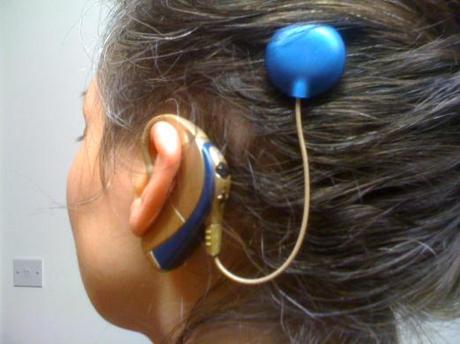The first ‘sound’ I got was a pulse. I wasn’t even sure that was a sound, so barely perceptible was it. It actually felt more like an aural backdrop – but maybe, that was the point.
It was only the start of the first tuning session for my cochlear implant (CI), and already it felt weird and rather scary. I’d just got my processor and headpiece, and almost immediately after it was placed on my ear, I felt as though I’d had a knock on the head. The audiologist explained that this was the effect of the magnetic headpiece locking with its internal counterpart. (It’s the only way I can know when it’s connected.)
I felt like Neo getting plugged into The Matrix for the first time, but instead of the giant database whooshing into view, I was experiencing the rude shock of waking up, naked and reborn, in a strange new aural world.
The next sound tuned by the audiologist was a specific high-pitched monotone that appeared whenever someone spoke to me.
It’s hard to explain. Having had absolutely no recollection of natural sound before I went deaf from meningitis at 16 months old, I can’t pinpoint the exact pitch I was hearing that day. Perhaps the best way to describe it is as a line cutting straight across an enormous invisible sound frequency chart, that twanged whenever the speaker’s voice hit it – about 10% of the whole sound, I’d estimate, possibly less.
I also got tinnitus, but it wasn’t necessarily any worse than the tinnitus I’d had before. I was simply more mindful of it, because I was working out how to hear with the CI – just like I used to as a child, after my headphones were switched on at the beginning of a school lesson.
The sounds produced by a CI are much more artificial than those produced by a digital hearing aid. Certainly the pitch jarred – both physically and with my memories of sound via a hearing aid – so much so that I went into shock, and I was glad that Miles was with me. It was odd to be getting with my processor an enormous carry-box containing replacement power-cells, a recharger, various wires, and colour covers all connected to me, instead of the single pocketable box and batteries that usually accompanied a new hearing aid.
I can see how traumatic a CI could be for a child, or even a late-deafened adult. It is a lot to ask of a person, and not necessarily a ‘better’ alternative to hearing aids.
One of the advantages of an effectively pre-lingually deaf person like myself having it in adulthood is that my brain has already had the experience of persevering with change. Not just going deaf, but also adjusting to hearing aids, and re-adjusting when my hearing levels dipped twice more in my life – at 11 years old just before starting secondary school, and again in November 1998.
When my digital hearing aid began to fail me three years ago, initial thoughts that my hearing levels had dropped again were proven wrong by a test that revealed no perceptible change.
Possibly, the texture of my deafness had changed instead, rendering the hearing aid useless. Again, I adapted. I am an adult well-used to my hearing changing abruptly, again and again, throughout my life. I don’t remember what it was like to be hearing. My mother and I agree that 16 months, when I became deaf, is much too young for me to have acquired spoken language properly.
I am not like my father-in-law, finally – and very reluctantly – accepting hearing aids after many, many years of struggling with the sluggish decline of his hearing. I have a strong track record in tenacity, and can certainly get used to the more discordant sounds from a CI.

Nevertheless I was very particular about who could accompany me to switch-on, not least because I knew how emotionally charged it could be. Persistent misconceptions that CIs make a deaf person ‘hearing’ made me very guarded about discussing it with other hearing people, and I wanted to have control over how those close to me reacted at switch on. It had to be Miles, and no-one else.
Afterwards, there were moments when I felt distanced from even Miles. He had to get used, too, to the idea of living with a CI user. At one point he leant over on the sofa to try talking into my ear, and for an instant I forgot I was wearing a processor, not a hearing aid. We have also experimented with the kind of hearing practice – where you voice single words to the person with your mouth covered – that I haven’t done since primary school.
I understand now why CI users tend to form their own community. It shouldn’t happen – we are after all still deaf, like the rest of the deaf community. It’s not out of political choice, necessarily, although CIs do have their detractors. It is more down to the kind of auditory experiences that CI users relate to that hearing aid users, and deaf people who don’t wear hearing aids, can’t.
The switch-on is not the only tuning session I have had; I have two more coming up in the next couple of weeks. The idea is to create a kind of aural topography, in order for my brain to establish foundations of hearing and build on them: hence the Matrix rebirth analogy.
In the last three days, I am already getting fuller sounds. The line across the giant frequency chart is seeping, like watercolour on damp paper. Yesterday I heard Isobel cry. She had to absolutely wail, like any toddler would, for me to notice.
In her short life, it is only the second time I have ever heard Isobel. The first was with the digital hearing aid arranged by my surgeon to test my perseverance – only half as loud, and much more nuanced.
Exciting though it might seem, I was unsure what to make of it. It was still that one seeping line on the blank chart – still only 10% of the sound. I wasn’t disappointed; far from it. I understood completely that I needed to give myself plenty of time, and was quite prepared to do so for as long as possible.
Once again I am Neo in his long, flowing overcoat, familiarizing myself with life in the Matrix, steadily taking in my new aural surroundings. As Morpheus says to his protégée in his inaugural fight: “Don’t try to hit me – hit me.”
Related articles:
- The cochlear implant: a deaf mother’s story (themostynthomasjournal.com)

